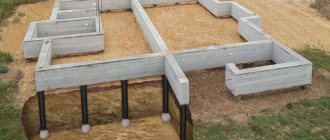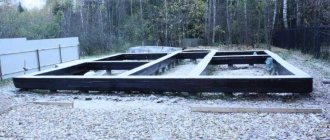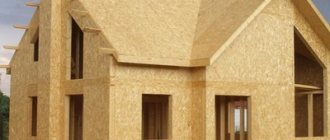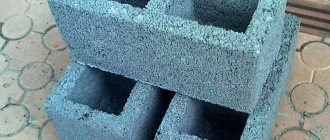When building a house, great importance is given to the construction of the foundation. We have said more than once that the foundation is the foundation of the future home. That's why it needs to be taken seriously. The soil and soil quality of the area where the house will be built is of key importance when choosing the type of foundation. Today we will look at the pros and cons of a pile foundation. The entire construction technology depends on the type of soil on the site, so before starting to build a house, we recommend that you definitely do geotechnical surveys. This will allow you to accurately determine the type of foundation for building your home.
In many regions of Russia, swampy, flooded or weak-bearing soils predominate. This makes the construction process problematic. This is especially true for the construction of private houses. But nevertheless, it is necessary to build somehow, and the use of a traditional strip or even slab foundation on such soils is simply unacceptable. In such cases, a pile foundation comes to the rescue. It is based on the installation of supporting structures. Such structures ensure good contact of the future house with dense layers of soil. And most importantly, they allow you to build very large and massive structures without fear for their stability. But is such a foundation good and safe? Are there any disadvantages of a pile foundation and what are they? Let's sort it out in order.
An example of a pile foundation for a house
Next, we will examine in detail the lighter version of the pile foundation. This includes screw piles. We'll tell you how to install screw piles so that they don't fail. And also what are the advantages of screw piles for the foundation of a house.
Foundation on screw piles
What are screw piles? What are their features and convenience? And how to make a foundation with their help? Screw piles are such a support structure. It is a system of pipes that are immersed in the ground to a certain depth. Spiral blades are welded at the bottom of these pipes (as in the photo). This design allows you to screw piles into the ground. And the blades play the role of cutting, with approximately the same effect as on screws. The sharp tip of the pile makes it easier for it to penetrate the ground. And the thread, in addition to being used for screwing, is also a support unit on which the pile actually rests.
How is the support supported and how reliable is it, you ask? We answer: such a pile is supported by the friction force that occurs between the soil and the side surfaces of the pile (pipe). This design is reinforced by the same blades that we have already talked about. They bear part of the load, which makes such a support very reliable, with proper installation, of course. By the way, the installation of such piles itself has a lot of subtleties that must be observed. Failure to comply with them may result in the pile being flimsy and unreliable. So, in order to evenly distribute the load on each pile, the installation is carried out according to a pre-calculated scheme. A so-called pile field is formed. It ensures an even load on each support.
Grillage
When the piles are already immersed, their upper parts are cut off in such a way that a flat plane is obtained. Then they make a grillage or otherwise call it a load-bearing belt. This is the main structure that distributes the load from the walls. And most importantly, thanks to it, the load on the pile system is distributed evenly, without overloading any of the piles, which gives this structure reliability and durability.
The structure and functions of the grillage are very similar to the design of a strip foundation. The difference in this design is that the grillage, instead of being supported on the ground, like a strip foundation, is supported on piles. In order for the structure to become rigid and less susceptible to lateral loads, the hollow tubes of the piles are filled with concrete after installation. This creates additional stability and rigidity of the structure.
Of course, there are both pros and cons of a pile foundation. But the clear advantage of screw piles is that when installing them, it is not necessary to immerse them until they come into contact with dense layers of soil, as with other piles. The peculiarity of their design allows them to reliably hold the building with sufficient penetration into the ground. Screw piles are a hanging type of piles.
Grillage arrangement
Construction of a pile-grillage foundation.
First, holes are drilled around the entire perimeter, into which roofing felt is inserted for casing. Then the associated reinforcement is inserted, which should protrude from the pit to connect to the grillage. The pits are filled with concrete and waited 7 days to reach the required strength.
Grillage reinforcement.
First of all, the formwork is assembled, on the bottom of which sand or insulation is laid. Waterproofing on the pillars must be placed on top, after which the reinforcement cap is tied in and connected to the pile reinforcement. When everything is ready, you can pour concrete. After the grillage has become stronger, you can remove the previously poured sand from under it, thus creating a gap. It is not recommended that the grillage between the posts lie on the ground.
For which buildings is a pile-grillage foundation designed?
Most often, prefabricated reinforced concrete grillages are used in country house construction for small, lightweight houses made of:
- glued timber;
- rounded logs;
- light brick;
- expanded clay blocks, foam blocks;
- sandwich panels;
- frame-panel.
What kind of soil is it recommended to use such a foundation?
A pile-grillage foundation is perfect for heaving soil with high groundwater, on the banks of rivers, lakes, and on almost any soil except rocky ones. To build on uncertain terrain, it would be good to inspect houses that have been built a long time ago and do not have skewed piles. We need to take an example from such buildings for more confident construction. If this is not possible, then it is better to contact specialists.
Pros and cons of pile foundations and screw piles
Below we will try to highlight the obvious advantages of screw piles. Of course, any choice in favor of one or another method of installing a foundation depends more on the conditions that exist specifically on your site. But we decided to highlight the general advantages that will help you make a choice based on your individual conditions. And so, the advantages of screw piles include:
- Fast installation.
- Screw piles can be installed manually. This fact makes it possible to build such a foundation next to ready-made buildings.
- Price. Screw piles cost much less than other types of foundations.
- Screw piles can be reused. If the need arises, such piles can be removed and reused elsewhere.
- The big advantage is that installation of screw piles does not require excavation work.
- Screw piles allow construction in areas where there are slopes or folds in the terrain.
- Another important advantage is that during installation you do not need to use complex equipment, which makes the installation process easier and cheaper.
The advantages of screw piles
The disadvantages of a pile foundation and screw piles in particular are given below. The disadvantages are associated not with the structure itself, but with the conditions in which it is unacceptable to use this type of foundation. Here's what it includes:
- Corrosion may appear on the piles, as operating conditions contribute to this.
- In regions where there is high seismic activity, the use of screw piles is prohibited.
- Do not immerse in rocky soil.
- If you plan to install screw piles on loose and weak-bearing soils that do not provide acceptable lateral support for the piles, then additional study is required to determine the sufficient immersion depth of the screw piles.
Often, as it happens, many of the shortcomings of screw piles are deliberately hushed up by manufacturers. In this regard, when choosing a pile type of foundation, you need to understand the design features yourself or have a trusted person who understands this. And most importantly, have an idea of the properties of such piles. To choose the most suitable and high-quality option for screw piles.
Screw pile design
Minuses
The disadvantages of pile foundations are:
- To carry out the work, high-quality geological exploration of the site and detailed soil analysis are required. Test drilling is carried out to the entire expected depth of the piles. All work must be carried out by trained and experienced people, which often becomes a serious problem.
- Driving piles requires construction equipment, which is not always possible to approach the site. The larger the size of the pile field and the length of the shafts, the more difficult it is to organize and coordinate the availability of the necessary mechanisms and the people who operate them.
- There is no possibility of creating a normal basement. The maximum you can count on is a small technical underground where some communications may be located.
Despite the presence of negative aspects, pile foundations allow construction in problem areas, which is why they are widespread in Russia and other countries.
What are the types of screw piles?
Screw piles come in various types. They are used depending on soil conditions and other parameters that we will consider. So what are the types of screw supports that are used in the world of modern construction? For convenience, we will divide all types of screw piles into categories.
By area of application in construction
For those who know little about the construction craft, it seems that this type of foundation is used very rarely. But that's not true. This type is used much more widely.
Below we list the areas in which pile structures, screw piles in particular, are widely used:
- Capital construction.
- Individual construction for housing.
- Construction of greenhouses.
- Construction of hangars.
- Fences or enclosures, etc.
- Bridges, piers and other hydraulic structures.
- Load-bearing supports of power lines, masts, etc.
Over the past few decades, the popularity of this type of base has increased significantly. This means that the scope of application of screw piles is only growing and this process is not over yet.
Screw piles design
What are the sizes of piles?
In the manufacture of screw piles, steel pipes of different diameters . Depending on the application, different pile sizes are used. The larger the scale of construction, the thicker the piles should be, this is understandable. But the most common are pipes with a diameter of 108 mm. This size optimally combines fairly good penetration into the ground and high load-bearing capacity.
The diameter range of pile pipes ranges from 57-219 mm. Of course, in some cases, pipes with a larger diameter can be used.
Since the topic of this article is devoted specifically to private housing construction, we will make an amendment that pipes over 159 mm are usually not used. Since with such a thickness there are already certain difficulties in driving piles.
The length of the piles is also key and has several options. Standard sizes range from 1650 mm to 9000 mm. The length of the piles is selected depending on the conditions in which the building must be erected. It is important to understand that the more complex the soil area, the longer the length should be chosen when using piles.
How many blades should there be?
Piles come in various designs. Designs come with one blade or with several blades. Single-blade piles are usually used only on relatively stable soils. Piles with several blades are more suitable for complex and low-bearing soils.
It is important to know. In order not to lose traction with the ground when installing piles, you cannot reverse (reverse movement when screwing in). And also the load on the pile should not be exceeded.
Of course, when constructing important buildings, especially if the soil is weak-bearing, then it is necessary to use multi-bladed piles. Since their design provides greater stability and can withstand higher loads. This is a definite plus in favor of choosing multi-bladed screw piles.
Types of piles
For critical buildings on weak-bearing soils, multi-bladed piles are used, which demonstrate greater resistance to possible loads. Also, an additional argument in favor of choosing just such piles can be the fact that with an increase in the number of blades on the pile, it becomes possible to reduce the diameter of the trunk. And this makes it much easier to dive into the ground.
But it is imperative to ensure that the wall thickness provides the required structural rigidity.
Types of screw pile tips
The main function of the tips is to take on the load when the pile is driven. Therefore, this creates high demands on this structural element. Let's take a closer look at what types of tips there are for screw piles and in which cases which tip is best to use.
Types of screw piles
There are the following types of screw pile tips:
- The first type of tips is welded screw pile tips . They are made by narrowing the thickness of the pipe. Wedge-shaped sections of the pipe are cut out, and then the remaining parts are connected in such a way that a cone is obtained. Next, the seams are welded into a single structure. In this way, a pointed end is achieved. But it is worth noting that this type is only suitable for relatively weak soils. Otherwise, possible obstacles and inclusions of hard areas will simply destroy such a tip.
- The second type of tips, which is distinguished by its reliability and durability, is the cast tips of screw piles. They are made by casting from durable steel, and then additionally attached to the pipe. Such tips are massive, have greater thickness and have the ability to destroy inclusions that occur when installed in the ground. These tips are perfect for difficult soils that have a high density.
Screw pile options
What material are screw piles made of?
The material used for making screw piles is, of course, steel, but the grade of steel may vary depending on the level of construction. Of course, the material directly affects the cost of the pile, so the higher the steel grade, the higher the cost. Usually they use steel from the usual St3 to the more durable St20. If it is necessary to build in highly aggressive soils, where the loads are high and there is the possibility of electrostatic corrosion of the material, fairly durable steel grades 30 KhMA and 09G2S can be used. Below is a table of properties for different grades of steel.
Properties table for various steel grades
Type of protective coating for screw piles
The protective layer that covers ready-made piles is of great importance. Zinc is most often used for these purposes. It is applied in layers to the piles. But the material itself must be very resistant to corrosion. This combination provides good protection, and this in turn increases the service life and reliability of the structure.
The polymer materials that are used for the coating are erased while screwing the piles into the ground, which means they do not fulfill their task. Such a coating is necessary only to protect the outer part of the pile. In addition, this coating requires regular updating.
With the advancement of construction technology, many engineers are proposing innovative methods for protecting piles. They offer different methods from mastics to a rubber layer. But such methods have not yet become widespread and popular among builders.
Piling technology
Driving reinforced concrete piles involves solving many issues, and choosing a scheme is only one of them. The second important choice is the decision about which technology for driving reinforced concrete piles will be used. Technology determines how piles are driven and what is used to drive piles under the foundation.
The choice of method is based on taking into account three factors:
- the soil . Each technology has its own characteristics, which are better revealed on a certain type of soil. In particular, we are talking about the speed of driving a pile;
- place . Some methods cannot be applied in urban areas, uneven terrain, the presence of underground utilities, etc.;
- pile _ Directly its length, cross-section, durability of the head.
Currently, pile driving technologies have gained recognition, which are listed in the table in descending order of popularity:
| № | Technology | Characteristic | Equipment |
| 1 | Percussion | Dynamic load | Hammer, pile driver |
| 2 | Pressing | Static load | Press |
| 3 | Vibration pressing | Dynamic and static load | Vibrator |
| 4 | Leader well | Dynamic or static load | Preliminary arrangement of the leader well, tools according to the selected technology |
| 5 | Softened soil | Dynamic and static load | Water supply, hydraulic hammer |
| 6 | Electroosmosis | Electricity | The pile acts as a cathode |
A brief overview of all the options shown in the table.
Impact pile driving technology
Considered the most productive. Allows you to drive up to 40 piles in one shift. The bottom line is that to drive the pile, the head is impacted using pile-driving installations (devices).
- hammer for driving piles. The hammer can be diesel, mechanical, steam-air, or hydraulic. Characteristics in the table:
Diesel hammers are considered the most popular. Characteristics in the table:
- pile driver. The driver's task is to correctly install the pile in the ground.
The productivity of the impact method is ensured by the action of two types of energy: impact (transmitted to the pile from the weight of the hammer) and explosive (due to the combustion of the fuel mixture).
The method has limitations due to the fact that the dynamic load applied to the pile head causes strong vibration. This makes it difficult to use the technology in densely populated areas or in dilapidated buildings of cultural or historical value.
How piles are driven using impact technology:
- complete driving of the pile. The impact power is 100% of the equipment power;
- installation of the pile and control of deviation from the vertical axis;
- the pile driver, using a winch, lifts the pile and delivers it to the pile driving installation;
- the pile is slinged and lifted;
- hammer work. The power of the first blows is 1/3 of the power of the equipment;
- failure or reaching the design depth.
Press-in piling technology
It belongs to the category of the most progressive, since the method is based on a static load. The pressing method can be used on any soil under building conditions of any density.
The essence of the technology is that the pile is constantly subject to a vertical load. The force of its impact increases until the design depth is reached or the soil fails.
Vibration-pressure technology for driving piles
A technology that combines the features of the previous two. In the case of its use, a vibratory driver acts on the pile head, which exerts a dynamic load of low amplitude. Thus, the pile vibrates slightly. Due to this, the density of the soil decreases, and the pile gradually sinks to a given depth from the static load. The method is justified for use in non-cohesive soil.
“Leader Well” pile driving technology
The leader drilling technology is an excellent alternative to the others, provided that the work is carried out in dense soil. The peculiarity of the method is to create a well with a diameter of 70% of the diameter of the pile trunk and a depth of 1 meter less than the length of the pile. Reinforced concrete piles will then be driven into the leader hole, which will push the already dense soil apart during the driving process. Due to this, the required strength of the pile installation will be achieved.
The technology is characterized by the absence of noise and vibration (when using a press) and high productivity (when using impact tools).
Pile driving technology “Softened soil”
The essence of the method is to change the characteristics of the soil. It has been noted that soil containing a significant amount of water has less resistance to loads.
Thus, the technology is based on the principle of water erosion (softening). To do this, a nozzle is placed on the heel of the pile, supplying water under pressure. The soil changes its structure and the pile goes in easily. At the same time, the last 1.5-2 meters of the distance the pile should be driven into the ground with a hammer.
Electroosmos pile driving technology
The technology is based on the use of electric current, which is supplied through the pile. The current softens clay soils, and the pile penetrates the soil more easily.
Optimal screw piles for the construction of a private house
Of course, you must understand that without a preliminary analysis of the soil and the state of the area, it is simply not possible to say that some piles are suitable and others are not. You also need to take into account the weight of the future house, and for this you need to calculate it at the beginning (in this article there are calculation formulas for a slab foundation, but the weight of the house does not change depending on the type of foundation). The table will help you.
Weight calculation
If we proceed from the specifics of the construction, which involves the creation of a relatively light house with a small number of floors, then the most appropriate option would be to use single-bladed trunks with a diameter of 57 to 108 mm, depending on the type and condition of the soil .
Let's take the following data as an example. We are planning to build a relatively light house with a small number of floors. Based on these conditions, the most suitable option would be to use single-blade piles with a diameter of 57 mm to 108 mm. Why is there such a big difference, you ask? Everything is very simple, the choice of diameter will depend on the condition and type of soil on which you plan to build the house. Of course, as we said earlier, in order to get more information and not make a mistake with the diameter and type of screw piles, it is necessary to conduct a survey of the site and a detailed study of the soil.
Another important indicator is the load that will put pressure on the pile. For example, let's say that with a diameter of 57 mm, a pile can withstand a load of approximately 800 kg . So it turns out that naming the pros and cons of a pile foundation and screw piles is not so simple. To do this, you need to know at least the construction conditions, the quality of the soil and the size of the building.
Harness
Pile foundation for a house
Reviews from private builders
Most owners who built a pile foundation on their own note the availability of the technology both in terms of price and labor intensity.
Difficulties arise when it is necessary to carry out engineering calculations and assess the risks of deformations. Sometimes individuals neglect regulatory requirements and use averages and correction factors in their calculations.
In practice, a violation of technology can lead to the following consequences:
- non-uniform subsidence of the structure;
- rupture of the connection between the supports and the basement or grillage;
- overconsumption of building materials and more.
Experts advise turning to professionals who can correctly calculate the foundation, which is especially important if the structure meets the first class of responsibility. You can read about special cases of construction on the forums - here and here.
Everything you need to know about the design and construction of a pile foundation can be found here.
For what buildings is it needed?
Screw piles can be used for various buildings. World practice has shown the ability of this type of foundation to successfully work with massive, heavy and tall buildings and structures.
However, in Russia the technology for creating this foundation has not yet been developed, so they are usually limited to the construction of auxiliary or outbuildings. For residential buildings, screw piles are used reluctantly and quite rarely.
Pile foundation, screw
Comparison of the cost of SF with other types of load-bearing structures
To assess the economic feasibility of supports, it is worth comparing the cost of laying one foundation using different technologies:
| Type of power structure | Construction cost |
| Reinforced concrete piles | from 1200 rub./pcs. |
| Bored piles | from 1000 rub./pcs. |
| Screw piles | from 800 rub./pcs. |
| Strip foundation | from 9800 rub./m3 |
| Slab foundation | from 5000 rub./m3 |
Service life of screw piles
If we take ideal conditions, which means that the soil does not have a destructive effect on the pile material, there is no corrosion, and so on, then the support can last about 300 years. And if you add galvanization of the pile, then it will last for 800 years.
Such statements are made by sellers, manufacturers and marketers of screw piles. Although, if you look soberly, they don’t have much basis for such statements. The thing is that not much time has passed since the invention of screw piles. Not even 300 years old yet. This gives the right not to take such statements and tricks seriously. Of course, there are no ideal conditions, whether we like it or not, the pile will be affected, and the banal fatigue of the metal did not disappear.
Ready piles
So it turns out that the realistic service life of a pile foundation on screw piles can be considered approximately 60-75 years . This depends on the conditions in which the pile will operate and the quality of the installation, as well as compliance with recommendations during processing. But one way or another, these are not absolute values, which means deviations in any direction are possible. But here's an interesting fact. The first engineer-inventor of screw piles, who patented them, Alexander Mitchell (April 13, 1780 - June 25, 1868) built structures on screw piles. He first proposed such piles as a support in 1833 in England. And what’s interesting is that some of the buildings are still standing and in use today. And almost 200 years have passed...
Alexander Mitchell aged 86 (April 13, 1780 – June 25, 1868)
Pile driving scheme
The location of the pile is determined during the development of the project for the future structure. Moreover, each project is unique; its development is preceded by a study of the area (soil, temperature conditions, building density, the presence of underground communications, the possibility of access for equipment, etc.). Material prepared for the website www.moydomik.net
In private and industrial construction, the following pile installation schemes are used:
- pile bush (in private construction under columns, in corners, etc.);
- pile tape (in private construction and for linear structures);
- pile field (in private construction for very large and heavy houses, used mainly in industrial construction for multi-storey buildings).
According to SNiP, piles can be installed according to one of three schemes:
- typical diagram(s) of pile installation. Is the simplest. Suitable for use in sandy and gravelly soils. The use of this scheme involves installing piles in turn - from the first to the last.
- sectional diagram of pile installation (b) . It is used when it is necessary to create a pile field when there is dense soil on the site. The specificity of using this scheme is that the piles of one section are driven first, then a row is passed, and the next section is formed. After all sections are arranged, the missing rows are filled in. The use of the scheme eliminates the risk of soil compaction.
- spiral (c) and (d) . Presented in two varieties. The first involves starting work from the middle of the pile bush, the second from its edges. The first method is recommended for working in dense soil, the second - in normal soil. The use of a spiral pattern ensures uniform redistribution of the load on the soil, which subsequently eliminates its movement.
The presence of a pile driving scheme (technological map) allows you to organize the work of equipment and the construction team, thereby minimizing time and money, and all operations are carried out quickly and accurately.
Pile driving scheme (technological map)
Can a pile foundation be considered capital?
Screw piles that are screwed into the ground can really withstand enormous loads. And be the foundation for heavy and massive structures. This gives grounds to rightfully consider foundations on screw piles not just full-fledged capital ones, but also very reliable.
In this matter, a certain psychological imbalance arises, since outwardly they do not look like a reliable support corresponding to the term “capital”.
Often people are scared by the appearance of such a design. From the outside, the piles look very flimsy and it’s hard to believe that such a support can support a large house. Because of this appearance, people simply have an imbalance. How can “this” be called “capital”? But engineers say the opposite; an indicative factor is that it is allowed to build residential buildings on pile foundations. This allows us to say with confidence that screw piles are a reliable and permanent type of foundation .
House on screw stilts
Construction of a pile-grillage foundation.
Construction of a pile grillage foundation.
In most cases, when the task of equipping basements is not set, the best solution would be a grillage foundation, which has the ability to withstand loads greater than individual piles.
It is installed on stable, calm soils for reasons of saving materials and time. Where there is a large freezing depth, heaving, weak soils, the construction of a foundation on piles with a grillage allows the construction of not only light frame structures, but also large log houses, brick or block houses.
How to make the right choice?
Having learned most of the pros and cons of a pile foundation, a logical question arises. How to choose screw piles, what you need to pay attention to when choosing so that they last a long time. When choosing screw piles, you need to concentrate on two components of this process.
- Determine the standard size and type of screw piles that are suitable specifically for your conditions, your soil and your house design.
- Directly select products that suit you, taking into account their quality and price.
When working with a construction company, these two stages are reduced to a minimum of your attention. The first stage is most often decided at the design stage of the future home. But the second stage is a question for the employees of the company that is building your house.
It also happens that you build a house yourself. Read about the pros and cons of such construction in the previous article. In this case, you need to choose screw piles personally. Here is a list of what you need to pay attention to when choosing screw piles.
- The pipe must have a wall thickness of at least 4 mm.
- The pile blade must have a thickness of at least 5 mm.
- Monitor the quality of welding and weld seams, they should be of the highest quality.
- A layer of galvanization is required; this will provide additional protection and increase service life.
- The tip matters too. We talked about their types. It is advisable to choose a higher quality one.
These few points will help you choose the best product. Do not choose piles based only on price, otherwise you will have to lose a lot more effort, time and money when demolishing an already finished house. Focus only on quality. If you are in doubt and feel that a certain type of product does not fully meet your requirements, it is better to refuse such a purchase. Otherwise more problems will arise.
Pros and cons of a pile foundation. Screw piles
Regulations for driving piles - regulatory documentation
Driving reinforced concrete piles - pile field
It should be understood that driving reinforced concrete piles is a labor-intensive process, requires the use of special equipment and is regulated by a number of regulatory documents (GOST, SNiP, TU, Standard Construction Series, instructions and orders). The list of basic standards allows you to understand how difficult this work is.
Detailed information can be gleaned from these documents, but to understand the process, we will provide brief information.
Screw piles, product prices
Like any other parameters, the cost is calculated based on the conditions of future construction. Therefore, each individual house project will have its own cost. We will take a very small project to simply show a diagram of how to calculate the cost. So that you can independently calculate the cost of a pile foundation for your project. So, our example will be as follows: we will calculate the cost of a screw-type foundation for a house 6 by 6 m. Based on the fact that the optimal layout of a pile field should consist of at least 9 piles. This is what we have.
Depending on the company and conditions, the customer will need to pay for the installation of each pile. The cost of installation will be approximately from 650 rubles to 1150 rubles per piece. And add here the price of the screw piles themselves. The price of screw piles depends on the diameter and length of the trunk. For example, BC-57, this means that a diameter of 57 mm and a length of 3 meters will cost 1100 rubles with installation or 1200 without such a service. If the product is selected BC-108, then the price, also for a 3-meter trunk, will range from 1150 rubles with installation of products and 1350 rubles without such a service.
Choosing a company for installing screw piles
Why is there a difference in price depending on the presence or absence of the installation option, you ask. It’s very simple; this move is designed to encourage the buyer to order installation of screw piles from the same company. Of course, such a choice is not always the best solution, this is due to the quality of the installation. It is necessary to study the history of installations of this company, read the reviews and only then make a final decision in favor of this option. Or, on the contrary, turn to another company that specializes in installation, and not in the sale of screw piles.
As a result, for our example, the cost of this type of foundation will be only about 20 thousand rubles. But please note that we only calculated the cost of the products themselves and their installation. You also need to add additional shipping costs and other overhead costs. keep this in mind.
Of course, depending on the company, prices may vary, but ours shows the average price. Therefore, be sure to find out the cost of all options and ask for a detailed report of what and how much it costs.
Cost calculation
pros
The advantages of a pile foundation include::
- High load-bearing capacity. One reinforced concrete pile, even immediately after immersion, can take a load of about 20 tons or more . After gaining structural strength (restoring soil strength), the load-bearing capacity increases to its maximum.
- The installation speed is much faster than the construction process of any other type of foundation. Driving one pile to a depth of 4 m by machine (a common option) takes several minutes . The only thing slowing down the work is the need to give the piles time to “rest” - exposure to restore the soil. Experts call this period “sucking,” meaning the dense enveloping of the trunk by soil particles. Typically this process takes up to 20 days, during which no load should be placed on the supports.
- The ability to build on the most difficult soils and at any time of the year. Sometimes there are doubts about the possibility of plunging piles into frozen soil . At the same time, only the uppermost, relatively thin layer hardens strongly. Below, the soil is almost always in the same condition and is suitable for any work.
- Using a pile foundation is often cheaper than building a strip foundation of the same size. This is especially evident on large foundations. Large quantities of materials have to be spent, labor costs increase in proportion to the size of the base . In such conditions, a pile foundation noticeably benefits in both speed of work and cost.
NOTE!
It must be taken into account that we are talking only about the appropriate conditions under which the pile type of foundation becomes an appropriate solution. In all cases where the use of strip foundations is possible, the use of piles is abandoned . The reason for this is the need to build a basement, which is impossible on pile foundations.
Brief and general installation diagram
Here we will very briefly, point by point, provide you with the procedure for installing screw piles. If you have never done installation before, be sure to study this material in more detail. The matter is not complicated, but there are many nuances that simply must be observed. Procedure:
- Mark the pile field.
- Screwing in piles.
- Filling pipe cavities with concrete.
- Trimming the tops to achieve a level surface.
- Install headers.
- Installation of grillage.
In modern construction, specialized machines are used to screw in piles. This machine provides better and faster installation of screw piles. And most importantly, it will ensure verticality, and there will be no rocking of the pile during screwing. And this, in turn, will give the most intimate contact with the ground. It is also advisable to treat welding areas and any damage found that appeared during the process with an anti-corrosion compound.
So we have finished studying the possible pros and cons of a pile foundation and screw piles in particular. Before you take action, be sure to read the reviews below . Since opinions about screw piles differ, and people say different things. Everything is very individual, so always choose based on your conditions for building a house.
Scheme for using screw piles
Driving screw piles
Design
To prevent the previously listed disadvantages, it is worth making a detailed calculation of the supporting part of the building, which consists of several stages:
- Engineering-geological research. Allows you to obtain complete information about the characteristics of the soil. They will become the main part of the initial data for future calculations.
- Collection of loads from all house structures.
- Calculation of the cross-section of piles, their length and distance between individual elements, carried out according to SP 24.13330.2011.
Advice! You can make an approximate calculation yourself. This will save on design costs.
We recommend studying “Calculation of a pile foundation with a grillage” (for bored piles), “What load can screw piles 89, 108, 133 withstand” (for screw piles).
Pros and cons of a pile foundation - reviews
Nikolay 5/5
It's been standing for 7 years now. The house on screw stilts showed excellent results. There are no comments or complaints, everything is reliable and durable. There have been no problems during these seven years. Many people complain that they made a mistake with the choice of piles, saying they rust and other diseases. In my case, I somehow didn’t notice anything like that. Of course, you need to tint it occasionally, but like any iron you need to paint it, otherwise what kind of owner are you?!
Alexander 3.5/5
I think that messing with screw piles is simply dangerous. Yes, I don’t want to say anything bad about the design. But the ease of installation would seem to be a plus, but nope. This business attracts a lot of crooks. They installed piles in the sand for us. They dug holes for no reason, although it is forbidden to do so. Then they screwed one in just 1.5 m and they said that there was no further movement. The reason given was that the pile failed. Of course, I realized that things were not going well and refused their services, found another company and entered into an agreement with it. And what do you think??? For some reason, all their piles went in like clockwork and to the required depth. Therefore, I want to warn everyone that they need to watch the installation carefully. Otherwise, God forbid, the house will collapse in half a year.
Angelina 2/5
We got acquainted with piles while building a bathhouse; my husband built it on screw piles. And now he’s offering to build a house on them, but I somehow doubt and am afraid. And their service life, as they say, is 50 years. How is it usually only 40? They rust constantly and need to be painted. But the bathhouse has been working great for 4 years now and no problems. But a bathhouse is one thing, and a house is completely different. I persuade my husband not to install it; I still want reliability for the house.
Pile failure during driving
The immersion depth of the pile is determined by the calculation method and is reflected in the project. However, in practice, the pile may not reach the calculated depth or may go below the specified level.
The case when a pile no longer sinks as a result of the force applied to it is called “soil failure” or “pile failure”.
The failure point can be calculated using the formula:
To make sure that the pile has definitely reached “failure”, a series of blows are performed (with impact technology) or the time during which force is applied to the pile head is increased (with pressing technology). These impacts, which do not lead to the advancement of the pile into the soil, are called “pledge”.
There is another term that describes the case when a pile does not sink due to overheating - “false failure”. In this case, work is suspended for a time sufficient to cool the tip of the pile located in the ground.
Pros and cons of a pile foundation - reviews
Andrey 3.5/5
When purchasing piles, I recommend everyone to look at the protective coating layer. In most companies, they coat everything with paint, but it falls off during installation. If you suddenly have even the slightest doubt, look for other piles; there are a lot of them now. The thickness of the metal also matters a lot. It happens that when screwing them in like an accordion, they simply twist. I almost got caught while taking piles. The sellers said that everything was safe and normal. But the pipes look flimsy and are also painted with some kind of red paint. It was good to hire a man who understands it, he criticized these piles so much that he immediately abandoned them.
Victor 3/5
I built a house 8.5 by 9 m. The sway is not bad, it is especially noticeable on the second floor. 26 piles, 108 mm ones were screwed in. But problems arose with the depth; they did not enter uniformly due to the complexity of the soil. One is 1.5 m, the other is 2.5 m. It seems like they did everything wisely, they turned the machine, the harness was done properly. The reason for the swinging has not been figured out, but I personally blame the piles.
Vladislav 3.5/5
There was little time and not much money, so I decided to build a 6 by 6 country house on screw piles. I was amazed how quickly all the work was done. Literally 3 days for everything about everything. And they tied it up quickly with a grillage. And the price pleasantly surprised me; I gave it half as much as any strip foundation would cost, as they calculated for me. And you can’t make a strip foundation in 3 days. The only drawback is that you have to apply anti-corrosion agent occasionally.
The process of driving reinforced concrete piles - stages
If we consider the complete process of driving piles, it can be described in several successive stages:
- delivery. Reinforced concrete piles are quite heavy products that need to be brought, unloaded and placed on the construction site in such a way as to minimize their movement during the driving process;
- development of a work plan. Taking into account the location of the pile and the work project, a route for the movement of the pile driver and hammer along the site is developed;
- site preparation. In particular: garbage removal, tree removal, leveling (if required), etc. In some cases, a pit is dug before installing the piles;
- marking the installation site of piles;
- marking the pile. The markings are applied with bright paint in increments of 1000 mm. The presence of marks allows you to control the degree and speed of penetration of the pile into the soil;
- equipment setup;
- driving piles using the selected technology.
Pros and cons of a pile foundation - reviews
Kirill 2/5
On the site I placed the gazebo on screw piles. But the neighbor had seen enough and built a one-and-a-half-story house on them. Of course he doesn’t complain, but I see how he crawls and works on his foundation twice a year. And it’s scary to look at, everything looks so flimsy. I think that there is no point in putting more gazebos and fences on such a foundation.
Mikhail 5/5
He built a wooden house from logs. But there wasn’t much money, I read a lot and decided to choose a foundation on screw piles. The house was small, 6 by 6. I installed 9 piles. The soil on the site is mostly loam, so we were lucky to drive it all the way to 3 meters. The check showed that the piles fit perfectly and do not wobble. Although many advised against installing piles, arguing that they were wobbly and not reliable at all. The house has been standing for two years now and I haven’t noticed any problems at all.
Peter 1.5/5
They built a frame house 6 by 9 meters. I chose the type of foundation - screw piles. The work took 3 months. At first we were very happy that we managed to build the house so quickly. But now, when I walk around the house or the washing machine is running, I can feel the vibration of the floor and walls. They say that the distances between the lags were large, but it seems to me that the piles failed.
Installing additional items
When constructing a pile-grillage foundation, it is necessary to arrange openings for ventilation in the foundation and lay pipes that can be used for heating, sewer, water supply systems and other communications. If you do not take care of the engineering and technical equipment of the house in time, later to install them you will have to partially destroy the grillage.
To preserve the foundation, it is imperative to provide vents for ventilation Source remontstroy.net
Do-it-yourself pile driving
Despite the fact that driving reinforced concrete piles generally requires the use of specialized equipment, it is quite possible to implement it yourself. Let's look at how to drive piles manually, with the caveat that the pile has dimensions acceptable for work.
Do-it-yourself installation of piles is carried out using impact technology. To organize a dynamic load, you need to assemble a tripod, hang several concrete blocks on it (serve as a counterweight) and a hammer. The hammer is raised by cables to the maximum height and fixed. Once the pile is installed, the hammer is released and the pile is driven into the soil. The procedure will be repeated until the required depth is achieved.
Cost of driving piles
In conclusion, a little about how much it costs to drive a pile and what determines the cost.
The price consists of the following parameters:
- priming. The more complex the soil, the higher the cost will be. There is a table of coefficients with which soil is recalculated. They also rely on it when setting prices;
- construction location. The farther from the location of the equipment, the more expensive it is;
- scope of work. Moreover, the greater the number of piles, the greater the discount the customer can claim. Note that the price is indicated for the footage of piles and their number.
Approximate prices are shown in the table.
Thus, driving piles is the only way to construct a reinforced concrete pile foundation.
More than 60% of structures on loamy soils are built on driven piles.
In most cases, reinforced concrete rods with a load-bearing capacity of up to 60 tons each are used.
You can learn about the features of a pile-driven foundation, the types of supports used and methods of their installation from this article.
Mistakes and recommendations for construction
Sometimes it is cheaper for a developer to order the construction of a turnkey driven foundation than to do the work himself. At the same time, even experienced craftsmen sometimes violate technology. Common mistakes:
- Low quality concrete . According to the standard, concrete must have a grade strength of at least M250, but in practice, unscrupulous suppliers can use raw materials of grades M180 and even M100. There are options when one rod is poured from two mixers, which leads to heterogeneity of the composition. The result is the same - premature wear of the foundation and the risk of destruction of the entire structure. Experts advise not to skimp on the quality of supports and to trust well-known suppliers.
- Different levels of piles protruding above the ground . The permissible error is 3 cm, which can be leveled by the brickwork or the thickness of the seam. In practice, there are differences of up to 10 cm, which cannot be compensated for by anything. Experts recommend monitoring the parameter using a laser level or pulling the threads at the same level.
- Refusal of geological surveys . The characteristics of the soil have a direct impact on the bearing capacity of the entire foundation, and in one area the physicochemical properties of the soil can vary greatly. The use of average values and outdated data will inevitably lead to erroneous calculations, which threatens premature wear of the foundation. Therefore, the geology of the site is an important stage before design calculations.











